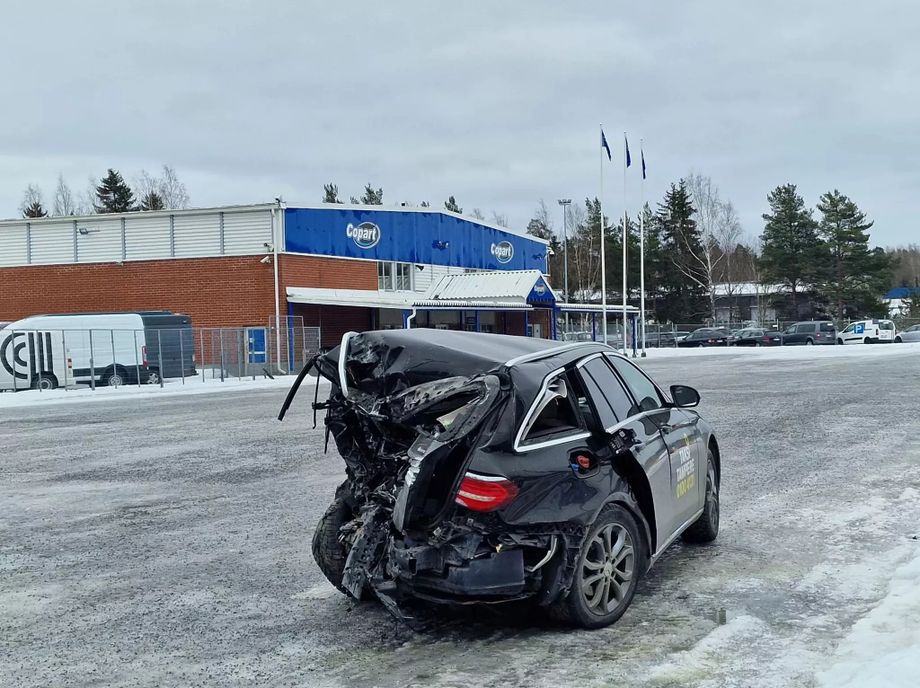According to the police investigation, the 20-year-old driver who was driving behind the taxi showed no signs of braking, swerving or trying to avoid the collision.
A taxi driver lost his life on Saturday in Tampere, when a Defense Forces car collided with the back of a taxi stopped at a traffic light with devastating consequences.
Accident investigator of the Finnish accident inspection SVT Oy Timo Suuronen according to the crash tests, situations like the Tampere accident are not tested.
– Not many crash tests are done on a setup like this. It may be that car manufacturers don’t even pay attention to building (after the car) controlled modification structures for a collision.
Suuronen studies car accidents and makes 3D modeling of them. When necessary, he has also appeared in court as an expert. He commented on the matter at a general level.

According to the police, a Defense Forces car crashed into the back of a parked taxi at considerable speed. Reader’s photo
– There can be structures in the rear that give more easily, but the starting point is to make the cabin stronger so that it doesn’t start to give in, he says.
Suuronen points out that there are rarely accidents that fully correspond to the layout of the crash test.
Angle of impact
According to the police, the taxi driver who died in Tampere on Saturday had stopped at the traffic lights at the intersection of Lempääläntie and Kuokkamaantie, when a vehicle coming from behind crashed into the back of the taxi at a considerable speed.
The case is being investigated as a homicide. According to the police investigation, the 20-year-old driver who was driving behind the taxi showed no signs of braking, swerving or trying to avoid the collision.
Based on the pictures, in the Tampere accident, the collision angle did not hit the middle of the taxi, but the left rear corner of the car. According to Suuronen, this indicates that the speed of the vehicle that collided with it has continued to be greater than that of the taxi even after the collision.
– This has an effect on the speed calculation, he says.
Where did the cars end up?
The car that hit the back was from the Finnish Defense Forces. The police suspect its 20-year-old driver of the murder. Reader’s photo
When doing 3d modeling, Suuronen has to take into account the weight and elasticity of the cars in addition to the speed. He himself has not been involved in the investigation, in which a Defense Forces car would have been a party, but possible armor and reinforced structures would have an impact on the assessment of the accident.
There is no unequivocal metric that tells at what speed a car accident victim dies. According to Suuronen, the essential thing is the change in speed caused by a collision in a car.
People who were riding in a car that was hit by a rear-end car at even low speeds of 20 km/h can get, for example, a whiplash injury.
When Suuronen starts investigating a car accident, he first pays attention to where the cars have ended up after the collision.
– Lay people generally seem to think that the damage indicates the speed of the collision. In reality, they don’t directly say very much, he states.
The victim died instantly
The 20-year-old man suspected of murder worked for the Defense Forces on a fixed-term contract.
The man had taken the car into use without permission and was heavily drunk while driving.
The accident happened around 5:30 on Saturday. The taxi driver had stopped at the traffic lights at the intersection of Lempäläntie and Kuokkamaantie, when a vehicle coming from behind crashed into the back of the taxi at a considerable speed.
The taxi driver died instantly.
#20yearold #driver #suspected #murder #taxi #crash #Tampere #accident #investigator #specializing #car #accidents #speaks
/img-s3.ilcdn.fi/0ede04f1a6df08929adc2bbed3de39cb457cadafff7f14c5f8e7692f547ec947.jpg)
/img-s3.ilcdn.fi/e57fa52e184db09c35b52966f5294e8bb7fb98ce761ee7ae7476e19c31678a3d.jpg)